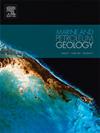The relationship between physical property evolution and reservoir formation in volcanic rock reservoirs: The Huoshiling Formation, Dehui Fault Depression, southern Songliao Basin
IF 3.6
2区 地球科学
Q1 GEOSCIENCES, MULTIDISCIPLINARY
引用次数: 0
Abstract
The Huoshiling Formation in the Dehui Fault Depression has emerged as a significant target for tight oil and gas exploration in volcanic rock reservoirs. This research investigates the tight gas reservoirs of the Huoshiling Formation through a combination of core observation, thin-section analysis, image recognition, and thermal simulation experiments. The study explores diagenetic processes, the factors influencing reservoir physical properties, and the development of a coupling of reservoir physical property evolution and oil and gas accumulation. Three primary types of diagenesis in the Huoshiling Formation have been identified. Detailed diagenetic evolution sequences are established through thin-section observation and analyses of authigenic minerals, pore types, and diagenetic mineral contact relationships, complemented by carbon and oxygen isotope analysis. An innovative technique integrating cast thin-section scanning and large-field stitching, and image recognition is developed to quantitatively assess the impact of various diagenetic processes on reservoir properties. Reconstructing burial, thermal, and hydrocarbon generation histories and integrating fluid inclusion homogenization temperatures, reveals the peak periods of gas and oil generation. A porosity evolution history map was constructed using the diagenetic evolution sequence, computational image analysis, and back-stripping inversion methods. This analysis elucidates the relationship between the evolution of reservoir physical properties and hydrocarbon accumulation timing in the Huoshiling Formation.
松辽盆地南部德惠断陷火石岭组火山岩储层物性演化与成藏关系
德惠断陷火石岭组已成为火山岩致密油气勘探的重要目标。通过岩心观察、薄片分析、图像识别和热模拟实验相结合的方法,对火石岭组致密气藏进行了研究。研究了成岩作用过程、储层物性影响因素以及储层物性演化与油气成藏耦合的发展。火石岭组主要有三种成岩作用类型。通过对自生矿物、孔隙类型、成岩矿物接触关系的薄片观察和分析,结合碳氧同位素分析,建立了详细的成岩演化序列。为了定量评价不同成岩作用对储层物性的影响,提出了一种集铸体薄切片扫描、大视场拼接和图像识别于一体的创新技术。通过对埋藏史、热史和生烃史的重建,以及流体包裹体均一温度的整合,揭示了油气的高峰期。利用成岩演化序列、计算图像分析和反剥脱反演等方法,构建了孔隙度演化史图。通过分析,阐明了火石岭组储层物性演化与油气成藏时间的关系。
本文章由计算机程序翻译,如有差异,请以英文原文为准。
求助全文
约1分钟内获得全文
求助全文
来源期刊

Marine and Petroleum Geology
地学-地球科学综合
CiteScore
8.80
自引率
14.30%
发文量
475
审稿时长
63 days
期刊介绍:
Marine and Petroleum Geology is the pre-eminent international forum for the exchange of multidisciplinary concepts, interpretations and techniques for all concerned with marine and petroleum geology in industry, government and academia. Rapid bimonthly publication allows early communications of papers or short communications to the geoscience community.
Marine and Petroleum Geology is essential reading for geologists, geophysicists and explorationists in industry, government and academia working in the following areas: marine geology; basin analysis and evaluation; organic geochemistry; reserve/resource estimation; seismic stratigraphy; thermal models of basic evolution; sedimentary geology; continental margins; geophysical interpretation; structural geology/tectonics; formation evaluation techniques; well logging.
 求助内容:
求助内容: 应助结果提醒方式:
应助结果提醒方式:


